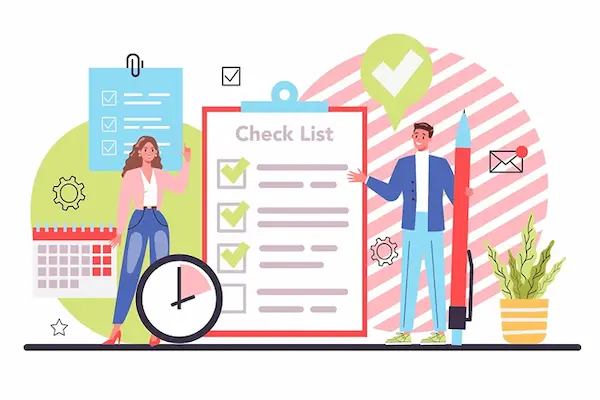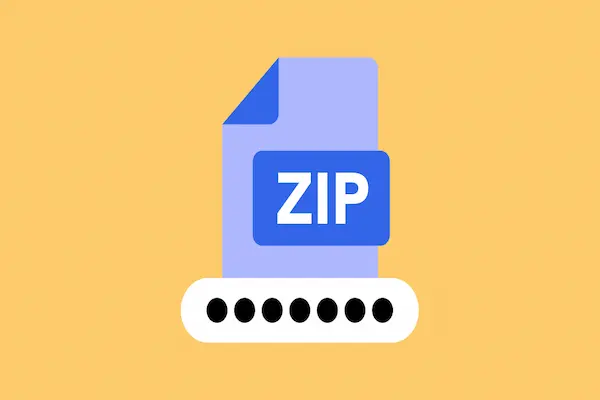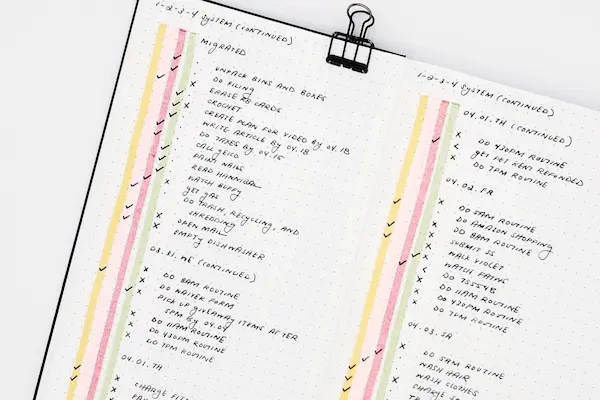A project checklist is an essential tool that helps keep tasks organized and ensures nothing is missed throughout a project’s life. It breaks down the work into clear, manageable steps, making the entire process easier to follow and track. Creating a project checklist involves listing all key tasks, setting priorities, and updating the list as progress is made.
By using a checklist, teams can stay focused and on schedule, reducing the risk of errors and delays. Well-made checklists also improve communication by clearly showing what needs to be done and who is responsible. This simple approach leads to smoother project execution and better results.
Understanding Project Checklists

Project checklists organize tasks and details, helping teams manage work more effectively. They provide a clear way to track progress and spot issues early. Using checklists simplifies complex projects by breaking tasks into smaller, manageable steps.
Definition and Purpose
A project checklist is a written or digital list of tasks and requirements needed to complete a project. It helps project managers keep track of deadlines, goals, and milestones.
The main purpose is to make sure nothing important is missed during a project. It offers a step-by-step guide to follow, which helps keep the team focused and organized. Checklists are often updated as projects evolve.
Checklists also serve to communicate what needs to be done to everyone involved. This keeps each team member aware of their responsibilities and timelines.
Benefits of Using a Checklist
Checklists improve organization by clearly showing what tasks must be done and when. They help teams avoid missing deadlines or skipping crucial steps.
They also support risk management by identifying potential problems early, allowing teams to address issues before they grow.
Checklists make it easier to allocate resources correctly. By knowing what each step requires, managers can plan time, budget, and staff needs better.
Using checklists increases efficiency and helps teams stay on track throughout the project lifecycle.
Identifying Project Requirements
A clear understanding of what a project needs is essential before moving forward. This means defining specific goals and collecting input from those involved. These steps ensure the project stays on track and meets expectations.
Clarifying Project Objectives
Project objectives define what the project aims to achieve. These goals should be specific, measurable, and aligned with the overall business purpose. Clear objectives help the team know what success looks like.
To clarify objectives, the project manager should ask questions like:
- What problem is the project solving?
- What deliverables are expected?
- What timeline and budget constraints exist?
Documenting these points creates a strong foundation for all project activities. It also helps avoid confusion later by keeping the team focused on agreed targets.
Gathering Key Stakeholder Input
Stakeholders include anyone affected by the project or involved in its delivery. Getting their input helps identify needs and potential risks early on.
This step involves:
- Meeting with clients, team members, and sponsors
- Asking about their priorities and concerns
- Collecting detailed information on their expectations
Using interviews, surveys, or workshops can help gather diverse viewpoints. This input ensures the project checklist covers all critical tasks and requirements, reducing surprises during execution.
Structuring Your Checklist
A well-structured checklist breaks down the project into clear, manageable parts. It helps keep track of all necessary actions and sets a clear path toward completing major goals. Organizing tasks and deciding which items need attention first are essential steps.
Organizing Tasks and Milestones
Tasks should be grouped by their type or the phase of the project. For example, planning tasks come first, followed by execution and review tasks. Breaking down large tasks into smaller, more specific actions prevents confusion and makes progress easier to track.
Milestones mark important points in the project timeline, such as major deliverables or deadlines. Adding milestones clarifies priorities and allows team members to focus on key achievements. Using a table or bullet list can help keep tasks and milestones clear and easy to follow.
Prioritizing Items Effectively
Not every task has the same importance or urgency. Prioritize items by their impact on the project and their deadlines. High-priority tasks should be tackled first to avoid bottlenecks later.
A simple method is to label items as High, Medium, or Low priority. High-priority tasks often involve dependencies—work that other tasks rely on. Ensuring these are done early helps keep the project on schedule. Lower-priority items can be handled as time allows, preventing overload.
Selecting Tools for Checklist Creation
Choosing the right tool for creating a checklist depends on the project’s size, complexity, and the team’s needs. Some prefer digital solutions with built-in features for tracking, while others find manual formats simple and effective. Both options offer clear ways to organize tasks and ensure nothing is missed.
Digital Tools and Templates
Digital tools like Microsoft Project, Jira, and Adobe Acrobat Pro provide powerful options for creating and managing checklists. These tools allow users to add interactive elements such as checkboxes, notes, and drop-down menus. Many platforms offer templates that help users start quickly and maintain consistency.
Some digital tools limit the number of checklist items per task but allow easy real-time updates and collaboration. Customization options help tailor lists to specific project types, from software development to marketing campaigns. Users can also automate reminders and track progress seamlessly.
Manual Methods and Formats
Manual checklists often take the form of paper lists, printed templates, or simple digital files like Word or Excel documents. These are best for small projects or when team members prefer a physical copy to check off items.
Creating a manual checklist involves listing each step clearly and organizing tasks logically. It is easy to adjust and requires no special software skills. Teams may use color coding or symbols to mark priority or completion. Although manual lists lack automation, they are straightforward and accessible to everyone without tech constraints.
Step-by-Step Process to Create a Project Checklist
Creating a project checklist involves breaking the project into clear tasks, deciding who will handle each task, and setting deadlines to keep the work on track. These steps help turn a project plan into a useful tool for managing progress and ensuring nothing is missed.
Listing Actionable Tasks
The first step is to list all the specific tasks that must be done to complete the project. Each task should be clear and actionable, meaning it describes a single, concrete action.
Tasks might include things like “draft project proposal,” “approve budget,” or “test software feature.” Avoid vague descriptions such as “work on project,” which can cause confusion.
Organizing tasks in order or grouping related tasks together helps create a logical flow. Using bullet points or numbered lists makes the checklist easier to follow.
Assigning Responsibilities
Once tasks are listed, it is important to assign who will complete each one. Clear responsibility ensures accountability and prevents overlap.
Each task should have one primary person responsible. Teams can use role titles or individual names. For example, “John – draft proposal” or “Design team – create graphics.”
If a task requires input from multiple people, specify their roles. A table format can help, such as:
| Task | Assigned To |
|---|---|
| Draft project scope | Project manager |
| Develop website | Web developer |
| Review content | Content editor |
Setting Deadlines
Deadlines keep the project moving forward and help track progress. Assign realistic due dates for each task based on the overall project timeline.
Deadlines should be specific (e.g., September 30) rather than vague (e.g., “soon”). This creates clear expectations.
It helps to mark priority tasks and available buffer time on the checklist. Tools like calendars or project software can send reminders to stay on schedule.
This way, everyone knows when their parts are due, reducing delay risks.
Reviewing and Optimizing Your Checklist
A project checklist must be accurate and useful for the team throughout the project. Regular review helps catch missing tasks and improve clarity. Feedback from those using the checklist is essential to make practical changes that fit the project’s needs.
Checking for Completeness
The checklist should cover all critical tasks needed to complete the project. The reviewer should compare the checklist items against the project plan, goals, and milestones to spot any gaps. This includes verifying deadlines, dependencies, and resources for each task.
Any missing steps or unclear instructions must be added or revised. It helps to use a table like this to confirm key areas are included:
| Task Category | Checked (Yes/No) | Notes |
|---|---|---|
| Planning | ||
| Execution | ||
| Monitoring | ||
| Closing |
This process avoids surprises later and ensures the checklist is a reliable guide throughout the project.
Incorporating Feedback
Collecting input from team members who use the checklist provides valuable insights. They can identify parts that slow work down, cause confusion, or are unnecessary.
Feedback can be gathered through surveys, meetings, or direct conversations. The reviewer should look for patterns like repeated questions or missed steps. After collecting input, changes should be tested in real workflows and updated regularly.
Clear communication about changes helps everyone stay aligned and confident in using the checklist. This keeps the tool practical and effective for current and future projects.
Best Practices for Managing Project Checklists
Effective project checklist management requires ongoing attention and clear tracking methods. This helps teams stay aligned and ensures tasks are completed on time without confusion or delays.
Updating Checklists Regularly
Checklists must be updated often to reflect any changes in project scope, deadlines, or resources. This keeps the list accurate and relevant. Teams should review checklists weekly or after major milestones.
Updating involves adding new tasks, removing completed items, and adjusting deadlines. It is also important to communicate these changes promptly to all team members. This prevents misunderstandings and keeps everyone on the same page.
Consistency in updates ensures the checklist remains a reliable tool throughout the project. Use digital tools that allow easy editing and version control to make this process smoother.
Tracking Progress
Tracking progress means regularly monitoring task completion and milestones. This helps identify bottlenecks and adjust work plans before issues grow.
Use clear indicators like check marks, color codes, or percentage completion to show task status visually. Assign responsibility to team members to update progress, which encourages accountability.
Frequent progress updates support better resource allocation and risk management. They provide a real-time snapshot, helping managers decide where to focus attention and when to intervene.





